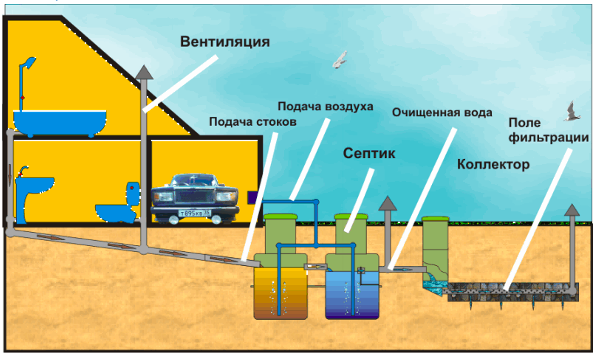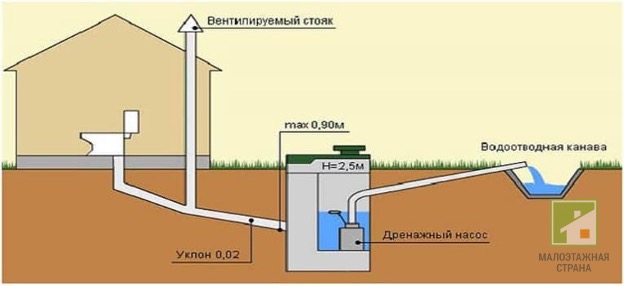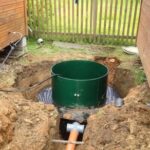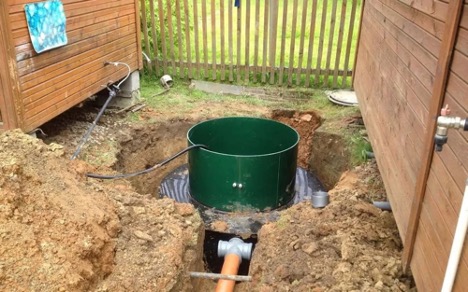The sewerage system and its internal and external elements: what is it for?
Sewerage is a complex infrastructure system designed to collect, transport and treat wastewater from residential, commercial and industrial facilities. The main purpose of sewerage is to ensure efficient and safe disposal of sewage, prevent environmental pollution and ensure sanitary safety for the population.
Sewage – is waste that is generated in the process of human life and production activities. They can contain a variety of contaminants, so their safe removal and cleaning is critical.

The content of the article
Internal and external sewerage: key differences
Internal sewerage is a network of sewer communications inside buildings and structures. It includes everything from plumbing fixtures such as sinks, toilets, and bathtubs to the internal piping that transports wastewater to the external sewer system. These elements of the system must meet strict sanitary and technical requirements, since they are in direct contact with the user and affect the sanitary conditions in the room.
The main task of internal sewerage is the effective collection and direction of wastewater from the building to the external sewer system. This is achieved through a properly designed and installed pipe system that takes into account slope, pipe diameter and other factors. Regular maintenance and repair of indoor drainage is key to preventing blockages, leaks and other problems that can affect the comfort and safety of building use.
External sewerage, in turn, is a system located outside the buildings. This part of the sewer system includes sewers, pipes, treatment plants and other elements located outdoors or underground. The main function of outdoor sewerage is to transport wastewater from many buildings to places where it is treated or disposed of.
Unlike internal sewerage, external sewerage is designed taking into account a larger volume of wastewater, as well as various external factors, such as climatic conditions, soil type and groundwater level. It requires an integrated approach to design, construction and operation, since any errors in these processes can lead to serious environmental problems and disruption of the entire system.
Sewer system design
The sewerage design includes a variety of elements, each of which performs a specific function. Examples of such elements:
- pipelines and fittings for transporting wastewater;
- wells for access to the system and its maintenance;
- wastewater treatment plants.
The sewerage counterslope is a complex structure that includes both internal and external elements. It is designed taking into account many factors, such as building type, terrain, climatic conditions and wastewater treatment requirements.

Types of sewer systems and their applications
There are several types of sewer systems, each of which has its own characteristics and applications. The main ones:
- Centralized sewerage - used in urban environments where large volumes of wastewater are required to be drained.
- Local treatment plants structures - used in places where connection to a centralized system is impossible or impractical.
Sewage refers to systems designed exclusively for the disposal of domestic and industrial wastewater.
Underground sewerage and its role
An underground sewer is a key element of the sewerage system that is located below the surface of the earth. This portion of the system includes the piping, sewers, pumping stations, and other components necessary to efficiently move wastewater from its source to its treatment or discharge sites. The main objective of underground sewerage is to ensure reliable and safe disposal of wastewater without risk to the environment and public health.
The key advantage of underground sewerage is its invisibility and minimal impact on the daily life of the city. Pipes laid underground do not take up valuable surface space and do not spoil the urban landscape. However, this aspect also entails difficulties in maintaining and repairing the system, since access to it is limited.
The role of underground sewerage in urban infrastructure
In urban infrastructure, underground sewerage plays the role of a vital element that maintains sanitation and hygiene. Without an effectively functioning underground system, the risk of flooding, groundwater contamination and the spread of infectious diseases increases. This is especially critical in dense urban areas where high population densities require efficient and rapid wastewater disposal.
Maintenance and repair of underground sewers require significant resources and specialized equipment. The work is carried out using modern technologies, such as visual inspection and hydrodynamic cleaning, which allows problems to be identified and corrected in a timely manner, preventing major accidents and ensuring continuous operation of the system.
Technological aspects and innovations in underground sewerage
Modern technologies play an important role in the design and operation of underground sewers. Using high-strength piping materials, such as polymer composites, ensures the longevity of the system and reduces the risk of leaks and damage. Innovative solutions, such as “smart” sewerage with sensors for monitoring condition and capacity, allow you to optimize the operation of the system and respond in a timely manner to possible problems.
The importance of underground sewerage in sustainable urban development cannot be overstated. It not only provides basic sanitation and hygiene needs, but also helps protect the environment by preventing pollution of water bodies and soil.Underground sewerage is an integral part of the urban ecosystem balance, contributing to the health and well-being of the population.
Conclusion: why do we need sewerage?
In conclusion, sanitation plays a fundamental role in maintaining the health and safety of a community. Without an effective sewerage system, it is impossible to imagine modern life in the city. Both the environmental well-being and the comfort of life for each of us depend on its reliability and proper operation.




